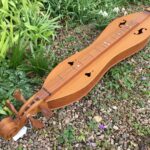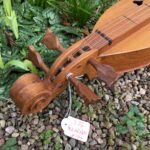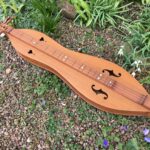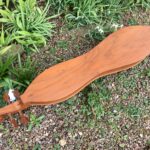Wallace G (Wally) Pergram
Wallace G (Wally) Pergram 1905 – 1981 was an Ohio dulcimer maker. Wally was supposedly one of the founders of the Mountain Dulcimer Club of Dayton, Ohio in the late 1960s. There’s a reference in Dulcimer Players News (1998) of Wally selling dulcimers at a local craft fair in the early 1970s (this one in Lafayette Indiana). In a local paper article from Marion, Ohio, dated October 1980, Wally was completing his 200th dulcimer.
3.84 Late 1970s 4 String 3 or 4 Course Hourglass Dulcimer. No date.
Deckle-edged oblong label in n/s soundhole, with typed details: “ * LITTLE LINDA */ MADE BY/ W G PERGRAM/ NO. 174”.
Big, but well-proportioned body, which is surprisingly light for its size. Made from walnut with a spruce or more likely cedar top. Back does not appear to be book-matched. Shallow kerfing to support top and back internally; back and top overlap sides in traditional manner (‘fiddle-edging’). Beautiful hand-carved scroll and pegbox, nicely proportioned and made from a single block of walnut. Long, hand-carved wooden pegs which seem to be very effective. Walnut fingerboard without overlay, but with mother of pearl markers at frets 3, 7, 10, 14 & 17. Early example of a 6+ fret, but not 13+. Nut and bridge are probably rosewood, neatly made but with no attempt at compensation on latter. Elegant soundhole design, chunky f-holes in LB and hearts with hole on UB. Solid tailblock with dowel and knob acting as string anchor. Overall length 37”, upper bout 5½”, lower bout 7½”, height 2¼”, FBW 1⅜”, VSL 26⅜” (medium scale), weight 2lb 1oz (937g). Currently strung conventionally, but could be arranged in equidistant tenor or baritone set-up – 0.011, 0.014, 0.024w. 6+, no 13+.
This is a well-considered and constructed dulcimer from a confident maker/player. It is reasonably resonant, with some volume and depth of tone. It has some beautifully carved features. But, it is still resolutely a traditional dulcimer, with its straight bridge and rather odd spacing between frets 5, 6, 6+ and 7. Has been recently strung for a low-pitched equidistant set-up, but now has a more conventional 3 or 4 course layout. Quite a high action. Intonation goes sharper as you move into the second octave.
Click on images below to enlarge.




